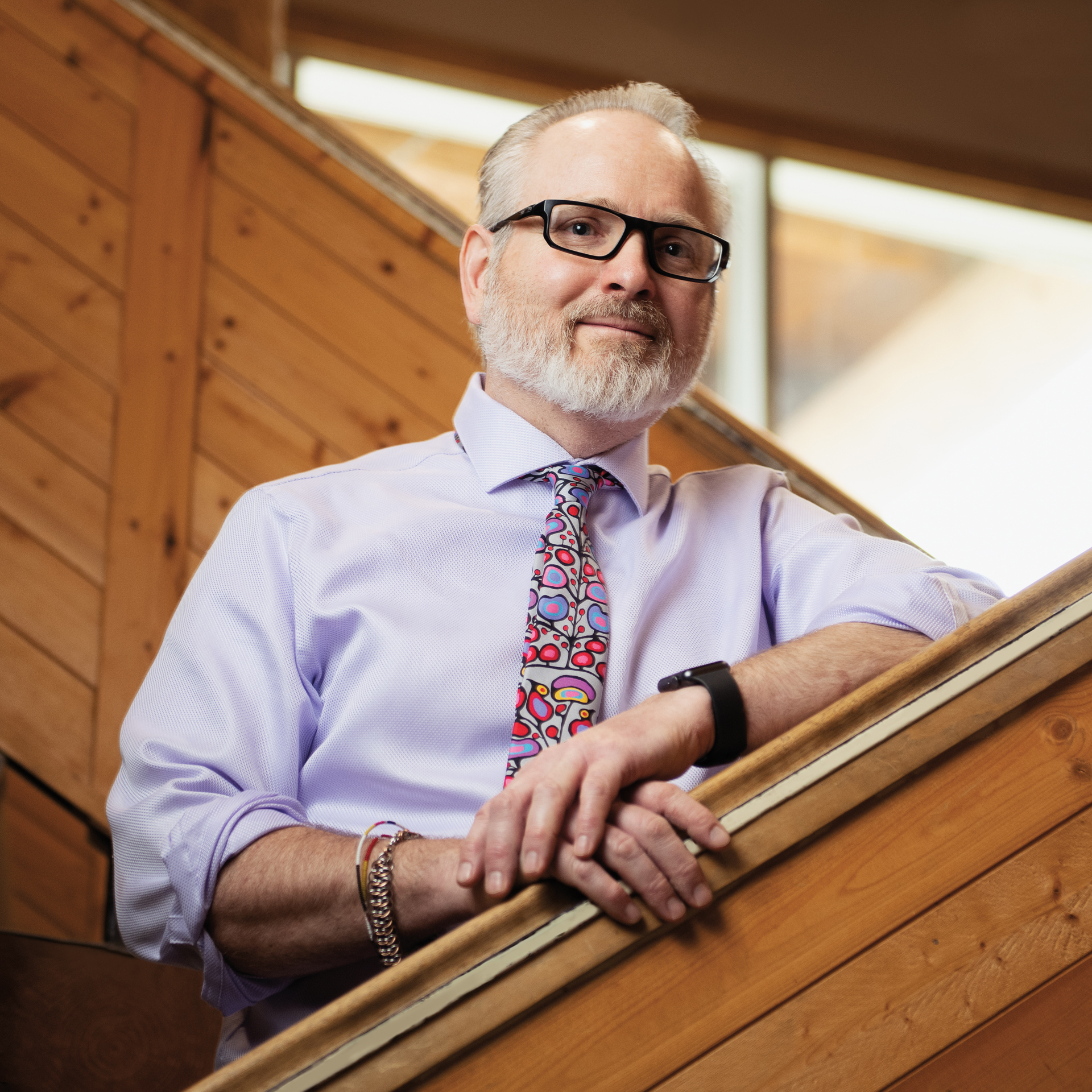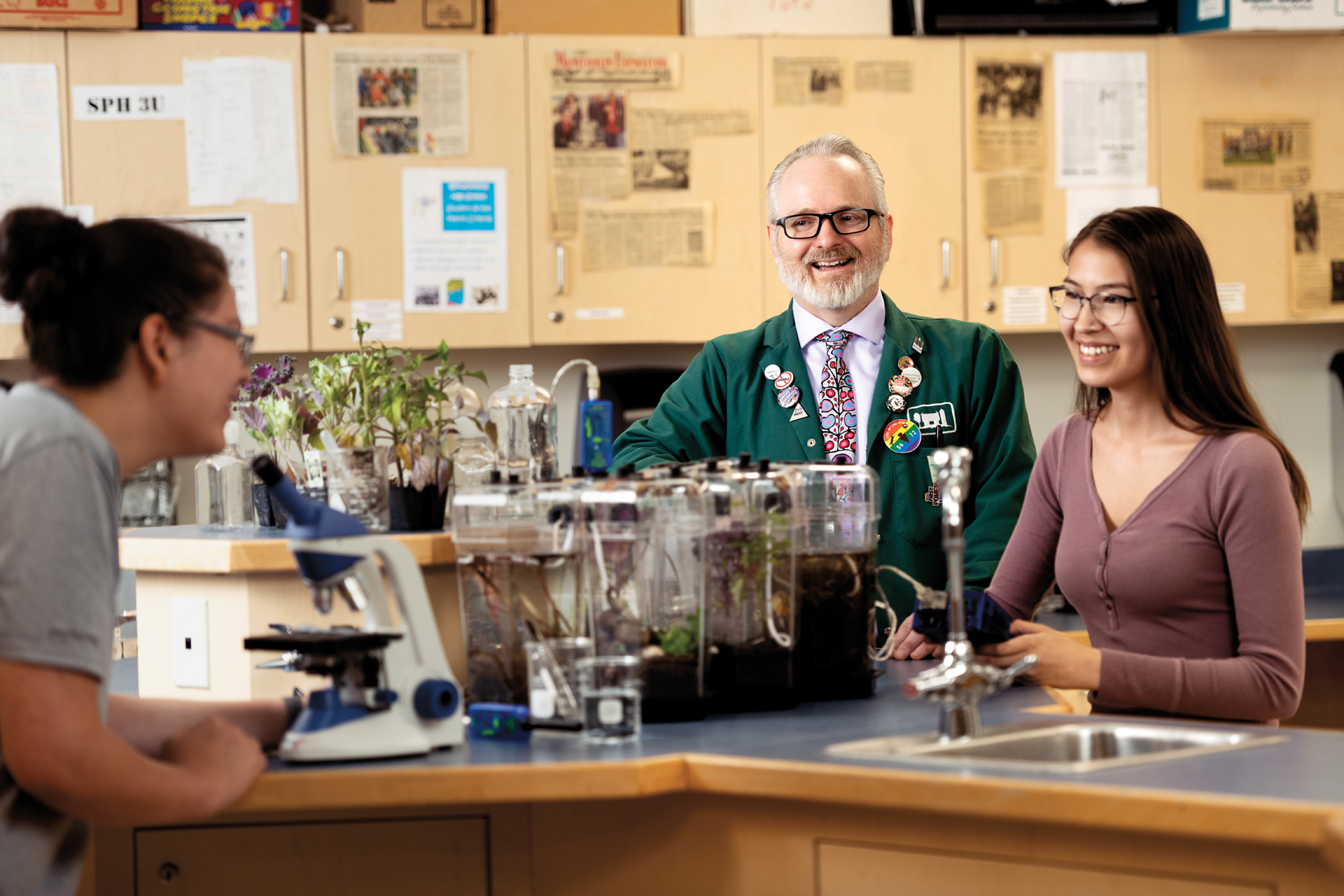Share this page

In a remote community on Manitoulin Island, Chris Mara, OCT, encourages students to take risks, make mistakes and find their own paths.
By Stuart Foxman
Photos: Gerry Kingsley
View our Great Teaching video archive.
What’s the formula to engage students? Take water, add diatomaceous earth and place it on a series of eight cat litter trays. That’s what Chris Mara, OCT, did as a student teacher during his 2000 placement at the Pontiac School in Wikwemikong, Ont., on Manitoulin Island.
His class had a physical geography unit. On his own, Mara decided to create a hands-on activity to show how rivers flow and erosion occurs. So he drove 2½ hours to Sudbury just to get the special earth (it’s a powdery substance used in pool filters). Then he drove back and built a water table.
Peter Baumgarten, the teacher supervising Mara, marvelled that Mara made the effort. How many student teachers would? “It struck me that someone with this type of initiative isn’t going to lose it,” says Baumgarten, who later taught alongside Mara at the local high school.
Learning is messy. That’s how Mara likes it. Students can take many twists and turns, like a winding river, on the way to comprehension. And sometimes textbooks, videos or presentations aren’t enough; students have to get their hands dirty.
“The students made a river and could see and feel the patterns in the earth,” he says, recalling that early project. “That’s the experience I wanted them to have. They were going to remember their learning. I wanted to be that kind of teacher.”
At Wikwemikong High School, Mara teaches math, science, computer science and manufacturing technology to Grades 10–12. He also coaches the school’s acclaimed robotics team.
“If you see a spark, your job as a teacher is to fan the flames and keep the curiosity alive,” says Mara, a 2018 recipient of a Prime Minister’s Award for Teaching Excellence.
Mara didn’t set out to be a teacher. At McMaster University, he studied science and philosophy. Then he moved to Ireland for graduate studies in philosophy. Back in Canada in 1992, he landed a job in a youth leadership program at the Anishinaabe Spiritual Centre in Anderson Lake, Ont. Three years later he re-located an hour south to Wikwemikong, First Nation community with a population of roughly 3,000.
Over time, Mara became interested in teaching as another way to make a difference with young people. He received his B.Ed. from Nipissing University in 2001.
Since 2002, Mara has taught at the high school, which has 160 students. The Wikwemikong Board of Education says it promotes lifelong learning and academic success guided by Anishinaabe world views, so that students “develop a sense of place and purpose.”
That’s essential to Mara, as an educator and as someone who’s not from the community. “There are traditions and connections here that I have to honour and respect,” he says.
His science room has the usual features — lab benches, periodic table, Smart Board — along with a poster of common Anishinaabemowin phrases, and another poster that says, “The voice of the land is our language.”
Mara recognizes that Indigenous students are under-represented in math and science fields. “There’s no acceptable reason for that,” he says.
He constantly seeks ways to make the curriculum memorable, often with a nod to the culture. For instance, when discussing the concept of zero, he’ll use the Anishinaabemowin term gaagego, which translates as “having nothing.” For another lesson on calculus proofs, Mara weaves in the Indigenous folklore of the “trickster.” What resonates with his students, he says, is that there’s a kind of trickster thinking to mathematics. You can’t break the laws of the universe; they always come back to you, as the trickster knows. But you can find workarounds.
When he makes such references, “You look around the room and see eyes perk up,” says Michael Staruck, OCT, systems principal with the Wikwemikong Board of Education. “Chris is from the outside, but students don’t treat him like he is. These things are important.”
High school math and science can be dense. Mara looks for any way in. He has done a rap about chemical displacement, and created a nursery rhyme-type song about metals and electrons. Former student Dehmin Eshkawkogan can still sing it from memory. “It always stuck with me,” she says.

“The reason you’re in science is that you’re curious. Have fun with that,” says Mara.
Eshkawkogan, who’s now studying health promotion at Laurentian University, also spent time on the school’s FIRST Robotics team. “It was a big deal. In our community we don’t get a lot of opportunities to do things like that,” says Eshkawkogan.
FIRST (For Inspiration and Recognition of Science and Technology) is an international not-for-profit organization that inspires interest in STEM. One way is through competitions, where teams of high school students build and showcase industrial robots that can perform a series of certain tasks.
Mara launched the program at Wikwemikong in 2015, scrounging the initial supplies from a recycling dump. He found a piece from a computer server closet that he figured could make a good robot frame, and collected stock metal pieces. The students borrowed hand tools from the school custodian. At a small school in a small community, you have to be resourceful.
Through the robotics program, the students learn coding, electronics and machining, but much more. Mara points to the critical thinking, problem- solving, entrepreneurship, resilience and collaboration inherent in what’s essentially a team sport.
“He emphasizes that we’re not just building a robot; we’re learning co-operation and leadership skills, and how to think outside the box,” says a robotics team member named Mary.
To Mara, the competitions also reinforce that the Wikwemikong kids can hold their own. “I want to give them opportunities to see how they are in relation to their peers, that they can stand shoulder to shoulder with the best and brightest not just in Ontario, but in the world.”
In their first competition, his team of five finished in the top third and captured two trophies. Today, the team includes about 20 students, and they’ve won multiple awards at subsequent competitions.
At the 2019 world championships in Detroit, the Wikwemikong squad was the only all-Indigenous team. They were one of three finalists for the Chairman’s Award, which goes to the team that is a model for others, and which is the most prestigious prize of the event. One of the team members was also a finalist for the outstanding student leadership award.
Robotics is also a credit course at Wikwemikong High School. Creating the team and program shows Mara’s determination, says school guidance counsellor Jillian Peltier, OCT. His confidence in the students helps them be just as dogged, she says. “Chris makes sure the kids believe in themselves. He sees the best in everyone.”
With robotics and all his classes, Mara doesn’t mind when things don’t go as planned, or when students don’t get it right the first time. “He gets excited, because that’s the opportunity to learn,” says Mary.
Mara sees learning as leap of faith. Students become vulnerable when they’re working through their understanding. “You don’t want a student to shut down because they got something wrong. Learning starts to happen when answers don’t align. Now we’re figuring things out, and no problem is insurmountable.”
Hannah Peltier, a former student who’s now studying archeology at Wilfrid Laurier University, says Mara creates an environment where students are comfortable to explore. “You feel safe to answer and ask questions, because he’s so encouraging,” she says. “He makes you feel that there are only happy mistakes.”
Putting yourself out there is easier, Mara suggests, when there’s mutual trust. “Teaching is relational,” he says. “Learning happens in the space between students and teacher. Be who you are, be consistent with how you act, give a piece of yourself to others, and you’ll make a connection.”
What do his students emerge with? “If you have a conversation with them at the end of his course, they’re all talking about what they’re doing next. They all have an answer,” says Staruck.
Mara has high hopes for his students and their generation. “I want them to understand that the challenges they face won’t be solved by the same thinking that caused them. We’ll require lots of voices at the table, and they have something to bring that’s unique,” he says.
He loves when students discover, whether it’s knowledge, what they have to offer or something about themselves.
“Success varies from student to student, whether it’s academic or a new sense of who they are,” says Mara. “It’s about opening up new worlds and helping them see the possibilities out there for them.”
The Ontario Certified Teacher featured in this profile has been recognized with a teaching award and exemplifies the high standards of practice to which the College holds the teaching profession.